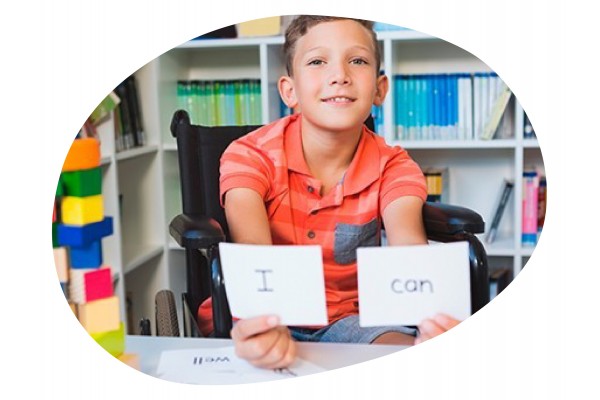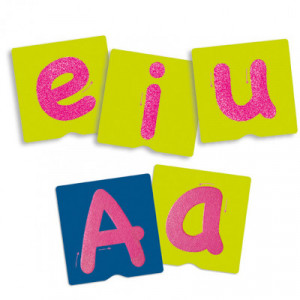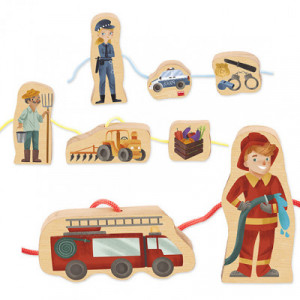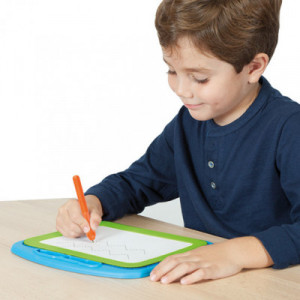Motor impairment (Cerebral Palsy)
Motor impairment affects each child's ability to move. That's why it's important that games give you autonomy, help you eliminate physical barriers and allow you to have control of your body.
If you are looking for games for children with motor problems or physical disabilities, we offer you a small selection of educational materials, sensory stimulation games, and games with easy to manipulate elements, so that you can always choose taking into account the interests and possibilities of your child.

Infantile cerebral palsy: types and degrees of involvement
The main characteristic of cerebral palsy, whatever the type of paralysis involved, is the brain's difficulty in correctly transmitting the messages it wants to the specific muscles. As we say, there are different types of paralysis and degrees that can affect children in different ways.
Types of Cerebral Palsy
The different types of cerebral palsy that exist are those that we detail below:
Spastic Cerebral Palsy
If we understand that the term spastic means rigid, we can deduce that spastic cerebral palsy has to do with rigidity. Specifically, children with this type of cerebral palsy have difficulty controlling their stretched and weak muscles, usually those that support the head, arms or legs.
This is the most common type of cerebral palsy, with approximately 70% of people with cerebral palsy being spastic. It usually occurs when the nerve cells in the cortex of our brain do not function as they should.
Athetoid Cerebral Palsy
When the central part of a person's brain functions incorrectly, it is called athetoid cerebral palsy.
Also known as dyskinetic cerebral palsy, it is a type of paralysis that mainly causes very slow and involuntary movements, which also become more serious when the person suffering from it suffers from fatigue or some emotional shock. They can also be attenuated when the person who has them rests and sleeps.
These slow and involuntary movements are also uncoordinated, making it notoriously difficult to carry out daily tasks.
Sudden changes in the muscles are common, from relaxed and flaccid to tense, and they generally present a lack of coordination in the movement of their arms and legs.
It can also be quite difficult to understand what they are trying to express in words, as they also have difficulty controlling their tongue, breathing and vocal cords.
Ataxic Cerebral Palsy
This type of cerebral palsy is mainly characterized by the difficulty of controlling one's own balance, as a result of an injury to the cerebellum in particular.
In this type of paralysis, the degree of affectation plays a fundamental role, since the lack of balance makes it very difficult for the person who suffers from it, and although with a lot of instability he could walk.
Mixed Cerebral Palsy
It is called mixed cerebral palsy when the person who suffers it has different lesions not only in one of its structures but in several.
This means that the manifestations presented by the affected persons are combined of several different types of paralysis.
Classification of cerebral palsy by topographic criteria
That is to say, we can make a classification according to the affected part of the body of the person who suffers from cerebral palsy, being the following ones:
- Hemiplegia: Cerebral palsy affects only half of the body.
- Paraplegia: affects the lower extremities.
- Tetraplegia: Both the upper and lower extremities are affected.
- Dysplegia: affects only the two legs, while the arms are only slightly or not at all affected.
- Monoplegia: In this case, only one member of the body is affected as a result of cerebral palsy.
The best activities for infantile cerebral palsy
Physical therapy for cerebral palsy is very necessary, but we can also cite some of the most effective activities that help children with cerebral palsy to be motivated to work and achieve improvement through play.
Individual games: the angler
This is a game in which you must provide a stick with a thread at the end to which a magnet is attached, like a fishing rod, and cardboard fish are placed on the ground, also with magnets.
The child should catch as many fish as possible with the rod, and every time he or she succeeds in catching them he or she should be applauded to motivate them.
Single player: basketball
Two baskets of different colours are placed in front of the child and a ball is provided, which must be thrown and basketed in the basket of the colour indicated.
With this game you will release stress but you will also be taking up your free time and entertaining yourself.
Single player game: puzzle
Like the previous ones, this game allows children with cerebral palsy to entertain themselves and occupy their free time.
You will need a puzzle, with a number of pieces adapted to the child's capacity, and give him or her orders to place the cubes as directed.
What is motor impairment?
Children with motor disabilities are named this way because their upper and/or lower limbs do not develop normally.
This disability is usually caused by an injury to the nervous system (around the spinal cord or brain) during pregnancy or during the postpartum period.
Children who have a motor disability do not have the same skills because they lack head control. They also have difficulty handling objects.
This disability also causes language problems. The articulation of words is not done correctly so communication is very difficult.
Characteristics of motor disability
Motor disabilities in children have different characteristics, which change according to the level of impairment of the motor system.
- If they have a milder degree of disability, they have motor skills in daily activities and improve them if treated appropriately.
- They show disturbances in the central nervous system that lead to seizures.
- They show difficulty in correctly managing their senses due to a lack of head control.
- They present difficulties in articulating words, they need specific systems to be able to communicate.
- Are partially or totally unable to move, do not walk, or have difficulty moving. They also have trouble moving objects or flexing their fingers.
- They have a better capacity for learning and reasoning than other children.
- In addition to these physical and intellectual problems, children with motor disabilities are often rejected by their peers and family members, and in other cases, are overprotected by their parents, which is also not a good thing since they will not learn how to help themselves.
Common causes
Motor disability in children occurs from three causes. Congenitally caused, problem at birth or illness or by some situation experienced during childhood.
When the baby is inside the mother, the physical problems associated with her mother influence her development. If the pregnant woman did not eat well, consumed drugs or alcohol, became ill with rubella, and shows Rh factor incompatibility, the child is at risk of being born with a disability.
Preterm birth, forceps, or a very long birth are also estimated to be the cause of motor disability.
On the other hand, accidents caused in the first months of the child's life can cause brain injuries, lead poisoning, lack of oxygen and infections accompanied by high fever such as meningitis, which can lead to physical or mental disability.
Education for children
Educating children with motor disabilities is a difficult job. It is not easy to find a school for a child in difficulty. His motor disability creates a number of barriers:
- Many schools are not properly signposted and do not have access areas for toddlers who have to use crutches, walkers or wheelchairs to move around.
- Education programmes and materials they work with are not adapted to the needs of children with disabilities.
- Certain school boards have biases that make admission difficult.
- Parents are afraid because of their disability and often overprotect children by preventing them from starting at an early age.
- If the child's disability is severe, it is best to evaluate other educational possibilities.
Parents of children with motor disabilities
Motor impairment in children shows a number of limitations that prevent children from being able to fend for themselves from the earliest stages. Once they are at the right age to attend school their learning progresses more slowly but with the help of parents and teachers they will improve it.
The help of parents in the educational process of these children is essential. Therefore, we are going to provide you with some recommendations to help your child stimulate his or her intellectual abilities.
- Concentrate on their interests, tastes and needs. If you can figure out what your child thinks, you can help him or her work through educational resources and educational games that will help them in their leisure time.
- Notice what daily situations and activities the child can practice with his or her attention, processing and storage of information.
- He works with didactic materials where he develops the exploration and manipulation of objects.
- Use sensory games that awaken their creativity.
- Believe in the little habit of reading.
Tips & Advice
Children with motor disabilities need their parents to boost their abilities in a joint effort between them and their educators.
From an early age, parents should engage in activities with their children in which they use the coordination of their eyes and arms to begin exercising. There are simple games such as constructions or balls of different dimensions and weights that help to perform these exercises.
There are more activities where fine motor skills (visual-manual) are practiced, such as with Smuzi Creative Clay, for example, through the manual creation of figures.
Drawing is another way to develop their skills. First with brushes of different colours, then with waxes and finally with pencils they will be able to work with all their skills.
Walkers or canes will help your child stand up. Little by little his balance will improve. It is important that you motivate and reward every effort.
Help him to walk and walk as it will be very beneficial to his health. This must also look like a game.
Games and Activities: what kind of activities can be done with children with motor disabilities?
Play is fundamental to children's development, and playing with children with special needs is even more important.
Children learn through play, which will help them to better understand concepts, assimilate and retain them, but it is also a great tool to stimulate their psychomotor development.
Many scientific studies show how children's games facilitate children's creativity and personality, as children learn through their experiences and exploration through different games.
In the case of children with some kind of disability, games can be therapeutic, as it will be a multisensory channel with benefits at different levels:
- Motor: Games can stimulate movement, for example by making it easier for the child to crawl or turn around, etc., with interactive or construction games.
- Sensory: Playing can help them develop visually, spatially and audibly by identifying sounds and objects.
- Cognitive: games that use shapes, colors and concepts will help them develop this level.
- Social: interacting with other children through collaborative or group games.
- Emotional: playing will promote children's self-esteem, as they will find in the games a link between their peers, whether with children with disabilities or not.
Ideas to realize with children with motor disabilities
In order to choose the games or toys that we are going to make with children who suffer from some kind of motor disability we must give ourselves advice and follow some advice that will help us to choose the one that best suits the specific needs of the child.
- We must place special emphasis on the common point with all children, as it will be very important that they are for all children, whether they have a disability or not, so that they can use them together, without distinction.
- It will be just as important to choose games that allow us to interact in different ways, and that allow us to change the rules, that is to say, we must look for the versatility of the toys in order to be able to adapt the games more easily to each particular case and its characteristics.
- The materials used must be appropriate to the child's age, even if their development is different from that of their age.
- On the other hand, if the motor difficulties are severe, all toys should be adapted to size and feel so that children with motor disabilities can handle them more easily. In this way we will help the child to adapt with some technical aids that may facilitate access to certain toys.
Motor problems: What can you do for your child?
Motor problems in children can be serious and affect not only their physical condition but also their psychological and social development. Motor skills are related to most human activities. Every movement, however simple it may seem, has a complex foundation in the brain that controls its ability to interact and adjusts to the precision of the muscles.
Both gross motor skills and fine motor skills may be affected in children with motor disabilities. Gross motor skills are those related to movements such as jumping, running, etc. In contrast, fine motor skills are those that require small, precise movements with significant force control.
These problems can have serious consequences for children because if they have disabilities and have not developed to the level of their age, they can lead to teasing and feel uncomfortable or ridiculed. They generate self-esteem problems and emotional stress that can degenerate into aggressiveness or some learning disorder.
You must take away your child's fear to get him to work hard and exercise his skills. Teach him he doesn't have to be afraid to make a fool of himself.
All toys and games bring many benefits to children, and in the case of children with motor disabilities we can achieve very positive results even by accelerating their learning.
Games and toys must always be adapted to the physical and psychosocial needs of children, so that they are not frustrated and their objectives are attainable, but always in line with the games of children who do not suffer from any type of disability, so as not to isolate them socially.
The games become a way to facilitate the inclusion of children with motor disabilities with other children, but they can also be used as a great tool to help rehabilitation, depending on the degree of impairment of each child.
In any case, the advice will be essential to be able to choose the games and toys that children with motor disabilities can play with other children, for their development and total integration.
There are many games that can be played together that can be really beneficial for this type of disability.

















